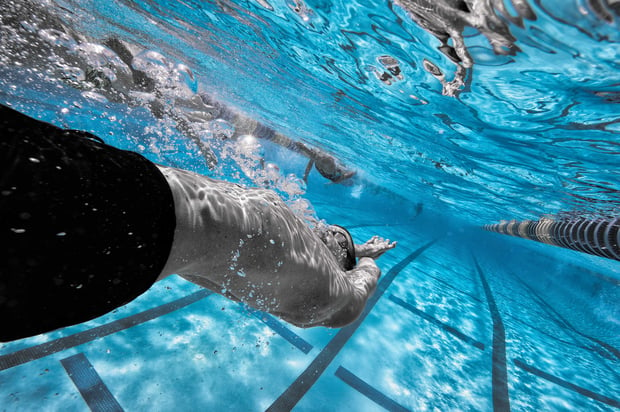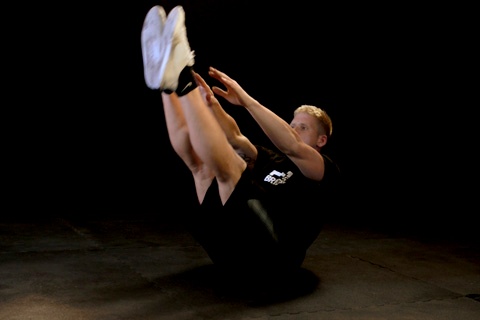Dryland Training: Strength & Efficiency for a Successful Backstroke

Welcome the backstroke installment of the swim building blocks! Here we dive into the strength training tips that can fine-tune your stroke. Backstrokers can use stroke specific exercises to harness more power in their catch and greater efficiency in their hip rotation. Underwaters are a large component of every backstroke race, so we’ll focus some exercises on leg strength too. Let’s jump into a few training tips you can begin using now.
V-Ups
Let’s start with the basics. A strong dolphin kick demands a strong core. The beauty of V-ups is that you can’t fudge the exercise—a strong core will get you to the top and back down successfully. The goal is to do these repetitions with integrity, so if you can only do sets of 6 to begin with, start with that. Then gradually increase your reps until you can do 3 sets of 15 high-quality V-ups. It is in the extension, or lowering of the legs, that athletes make the greatest strength gains in their abs. This is where the muscle definition also comes out. Use V-ups to maintain a more powerful dolphin kick throughout your race.
MB Russian Twists
One of the cornerstones of backstroke is hip speed through the rotation. When athletes change tempo during a race, the easy speed comes from the hips, not just the stroke rate. Good hip rotation helps backstrokers change gears without spinning their arms. A great exercise to replicate the demand on one’s core for hip rotation is the MB Russian Twist. In an elevated crunch position with the core continually engaged, the athlete uses a medicine ball to add resistance as he or she twists the abdomen side to side. Keeping a long line in the spine with the chest and chin tilted upward, the athlete must pass the ball from one side to the other by rotating through the body and not simply through the shoulders. Simultaneously keeping the feet elevated 1 inch off the floor will add complexity to this exercise.
DB Pushup-2-Row
The dumbbell pushup to row exercise is a great way to build strength through the triceps and lats, both of which are critical to a powerful catch in backstroke. The added stability challenge of maintaining a perfect plank during the single arm row reinforces the body connection that backstrokers need while they are mid-stroke. Use this exercise to learn how to engage your triceps while keeping a hydrodynamic bodyline in the pool.
SB Streamline Crunches
These crunches are an excellent simulation of underwaters. The swiss ball places the body in the correct position that underwaters demand, and each rep forces the athlete to engage the core from chest to hips while maintaining a strong streamline. The overhead hand position makes this exercise quite the ab burner, building the necessary endurance for 100 and 200 back races where underwaters can make or break your race. This is one of those exercises where technique largely influences how much you get out of it, so move steadily with a proper streamline throughout.
TRX Mountain Climbers
A leg burning exercise is always an appropriate backstroke-specific dryland tool. Use the TRX mountain climbers to develop endurance in your quads as you continue to emphasize stability with the alternating leg movements. While this is a leg-pumping exercise, continue to engage your entire body from shoulders to toes, just like you would in the pool.
Recap
Dryland exercises that focus on body position and stability will help you maintain a better connection in the pool from catch to kick. Core and leg exercises are the name of the game, so start fine-tuning your dryland with the tips in training presented here today. For more strength training tools, check out our other articles on freestyle, fly, and breaststroke!
About the Author

At Bridge, we are all athletes and coaches first. As athletes, our team has experienced everything from riding the pine on JV, to winning NCAA championships, to competing in the Olympic Games. As coaches, we have helped countless athletes reach their full potential, winning everything from age group section championships to Olympic Gold Medals.
Related Posts

The Best Bench Press Variation You’re...
This post is part of our Coaches Corner series with Taylor Rimmer. Taylor is NSCA-CPT, StrongFirst...

Does Powerlifting Harm Heart Health?
A recent study has discovered that a 12-week supervised strength training program (SSTP) may result...

Barefoot Running: Is It For You? |...
Run Free: Consider Less Cushion
Updated October 2020:
With more athletes looking for ways to...
.png?width=150&height=50&name=BRIDGEBLOG(1).png)
